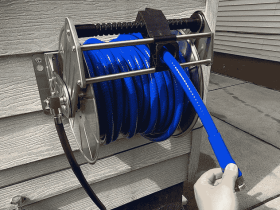For those with limited living space, making efficient use of every square inch is of the utmost importance. From multi-tasking furniture to organizing hacks, there are a multitude of options to live comfortably in a small apartment or dorm room.
Using vertical space can be an excellent way to make the most of any room in your home, including your kitchen.
When considering kitchen space, can you place a microwave on top of a fridge?
The short answer is yes. There is no significant harm to placing a microwave atop a refrigerator. However, you should consider a few things before stacking your microwave on your fridge.
Continue reading for some helpful pointers.
4 Things to consider before placing a microwave on top of a refrigerator

Before you place your microwave on top of your refrigerator, consider the following to ensure your safety and avoid injury or damage to your home or appliances.
1. Stability
Before you rearrange your kitchen entirely, be sure your fridge is sturdy enough to support the weight and size of your microwave. Do not place a too-big microwave atop a smaller fridge, such as a mini-fridge.
Check your fridge to make sure the top is flat before placing a microwave on top.
2. Power Source
Refrigerators and microwaves are large energy consumers. Before you plug both appliances into one electrical circuit, be sure it can support both simultaneously. Otherwise, the circuit will trip.
According to Energysage, the average microwave can consume from 600 to 1,000 watts, whereas home refrigerators consume between 300 to 800 watts.
If you don’t know your microwave’s wattage or cannot get it from the owner’s manual or the manufacturer’s website, you can estimate it with a ‘Time-to-Boil’ test. The USDA recommends you:
- Add 1 cup (8 fluid ounces) of water in a 2-cup microwave-safe glass cup.
- Add ice cubes and stir until the water is ice cold and remove ice cubes.
- Pour out any excess water, ensuring only 1 cup remains.
- Set the microwave to 4 minutes.
Once the water boils, use the following to determine wattage.
- Water boils in less than 2 minutes – microwave is 1,000 watts or more.
- Water boils in 2 ½ minutes – microwave is 800 watts or more.
- Water boils in 3 minutes – microwave is of average wattage, between 650-700 watts.
- Water boils in 3-4 minutes – microwave is slow, between 300-500 watts.
If your circuit cannot support the two appliances’ wattage, ensure that you plug them into outlets from different circuits.
Additionally, do not use extension cords to plug ANY appliance into another circuit. Continued use of extension cords can damage appliances and their internal electrical system over time.
3. Ventilation
When microwaves are in use, they expel heat through vents on the sides or the back.
Therefore, if you place a microwave on top of a fridge, be sure its vents are not obstructed. Along the same lines, ensure the refrigerator is not pressed against a wall or any other surface.
Both appliances must have enough space around them for proper air circulation. Otherwise, they can overheat, leading the appliance to malfunction or cause a fire hazard.
4. Vibration
When refrigerators cycle on, they tend to vibrate, some more so than others.
Consider your refrigerator’s vibration before placing any microwave on top of it as the vibration can slowly damage the microwave oven’s internal parts, which can reduce its life span.
Furthermore, the refrigerator’s vibration can cause the microwave to slowly shift from its place, making it unstable and a potential hazard.
Alternatives to Placing a Microwave on Top of a Refrigerator
If placing a separate microwave on top of a fridge is not an option for you, but you still want to save space in your home, here are a few alternatives you can consider.
- Install a Wall Mount – There are many different wall mounts to support a variety of microwave sizes. Find the right one for your space to free up much-needed counter real estate.
- Acquire a Microwave Stand – The right size and style of microwave oven stand can do wonders for your space. Some come with extra shelves which could add to your storage space. Be sure to measure your space and microwave oven before purchasing a stand.
- Remodel Your Kitchen – If you are already planning to remodel your kitchen, consider including a built-in microwave. The streamlined look can do wonders for your space!
- Microwave-Refrigerator Combination – If you still want to use your vertical space, a microwave-refrigerator combination might be the best option for you as they only require one plug. Options range from full-size refrigerators to mini-fridges.
Final Thoughts
Placing a microwave on top of a fridge can be a great hack to save space in a small kitchen. While doing so does not cause significant harm, it is important to consider a few things before placing two high-wattage appliances on top of each other.
Once you’re well informed, you can make the best decision to make the most of your living space.
Sources:
https://www.energysage.com/electricity/house-watts/how-many-watts-does-microwave-use/
https://www.energysage.com/electricity/house-watts/how-many-watts-does-a-refrigerator-use/
https://ask.usda.gov/s/article/how-do-you-determine-the-wattage-of-your-microwave-oven
https://www.summitappliance.com/microwave-refrigerator-combinations











Leave a Review